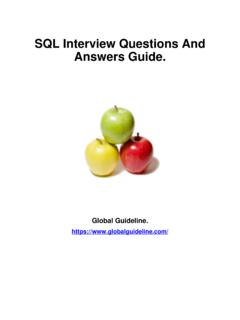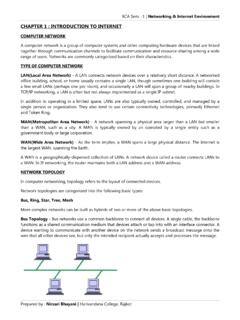Transcription of System Administrator Interview Questions And Answers …
1 System Administrator Interview Questions And Answers Guide. Global Guideline. System Administrator Interview Questions And Answers G. System Administrator Job Interview Preparation Guide. lo ba lG. question # 1. Explain Active Directory? ui Answer:- Active Directory provides a centralized control for network administration and security. Server computers configured with Active Directory are known as domain controllers. Active Directory stores all information and settings for a deployment in a central database, and allows administrators to assign policies and deploy and de update software. Read More Answers . question # 2. lin Define Domain Controller?
2 Answer:- A domain controller (DC) or network domain controller is a Windows-based computer System that is used for storing user account data in a central database. It is the e centerpiece of the Windows Active Directory service that authenticates users, stores user account information and enforces security policy for a Windows domain. Read More Answers ..C. question # 3. Explain Group Policy? Answer:- Group Policy allows you to implement specific configurations for users and computers. Group Policy settings are contained in Group Policy objects (GPOs), which O. are linked to the following Active Directory service containers: sites, domains, or organizational units (OUs).
3 Read More Answers . M. question # 4. List the different kinds of group policy objects? Answer:- There are two kinds of Group Policy objects: * Local Group Policy objects, are stored on individual computers. * Non-local Group Policy objects, which are stored on a domain controller, are available only in an Active Directory environment. Read More Answers . question # 5. Define LDAP? Answer:- LDAP (Light-Weight Directory Access protocol ) determines how an object in an Active Directory should be named. LDAP is the industry standard directory access protocol , making Active Directory widely accessible to management and query applications. Active Directory supports LDAPv2 and LDAPv3.
4 Read More Answers . question # 6. Define GPOs (Group Policy Objects)? Answer:- A Group Policy Object (GPO) is a collection of settings that control the working environment of user accounts and computer accounts. GPOs define registry-based policies, security options, software installation and maintenance options, script options, and folder redirection options. Read More Answers . question # 7. Define SYSVOL folder? Copyright Page 2/13. System Administrator Interview Questions And Answers Answer:- The SYSVOL folder stores the server copy of the domain's public files that must be shared for common access and replication throughout a domain. All AD databases are stored in a SYSVOL folder and it's only created in an NTFS partition.
5 The Active Directory Database is stored in the % System . ROOT%NDTS folder. Read More Answers . question # 8. G. Define garbage collection? Answer:- lo Garbage collection is the online defragmentation of the Active Directory which happens every 12 hours. Read More Answers . ba question # 9. Define Domain? Answer:- lG. A domain is defined as a logical group of network objects (computers, users, devices) that share the same Active Directory database. A tree can have multiple domains. Read More Answers . ui question # 10. What is DNS and which port number is used by DNS? Answer:- de The Domain Name System (DNS) is used to resolve human-readable hostnames like into machine-readable IP addresses like DNS servers use UDP port 53 but DNS queries can also use TCP port 53 if the former is not accepted.
6 Read More Answers . lin question # 11. What are main email servers? e Answer:- Email servers can be of two types: * outgoing mail Server (SMTP). Most outgoing mail servers use SMTP ( simple mail transfer protocol ) for sending emails. The outgoing mail server can belong to your ISP or to the server where .C. you setup your email account. * Incoming mail Server (POP3, IMAP, HTTP). The incoming mail server is the server associated with an email address account. There cannot be more than one incoming mail server for an email account. In order to download your emails, you must have the correct settings configured in your email client program. O.
7 Read More Answers . question # 12. M. What are the main email ports? Answer:- * POP3 - port 110. * IMAP - port 143. * SMTP - port 25. * HTTP - port 80. * Secure SMTP (SSMTP) - port 465. * Secure IMAP (IMAP4-SSL) - port 585. * IMAP4 over SSL (IMAPS) - port 993. * Secure POP3 (SSL-POP) - port 995. Read More Answers . question # 13. Explain Forests, Trees, and Domains mean? Answer:- Forests, trees, and domains are the logical divisions in an Active Directory network. * A domain is defined as a logical group of network objects (computers, users, devices) that share the same active directory database. * A tree is a collection of one or more domains and domain trees in a contiguous namespace linked in a transitive trust hierarchy.
8 * At the top of the structure is the forest. A forest is a collection of trees that share a common global catalog, directory schema, logical structure, and directory configuration. The forest represents the security boundary within which users, computers, groups, and other objects are accessible. Read More Answers . question # 14. Explain lingering objects? Answer:- A lingering object is a deleted AD object that still remains on the restored domain controller in its local copy of Active Directory. They can occur when changes are Copyright Page 3/13. System Administrator Interview Questions And Answers made to directories after System backups are created.
9 When restoring a backup file, Active Directory generally requires that the backup file be no more than 180 days old. This can happen if, after the backup was made, the object was deleted on another DC more than 180 days ago. Read More Answers . question # 15. What domain controller allow? G. Answer:- A domain controller allows System administrators to grant or deny users access to System resources, such as printers, documents, folders, network locations, etc., via a lo single username and password. Read More Answers . ba question # 16. Define AD database stored? Answer:- lG. The AD database is stored in Read More Answers . question # 17. ui When we use WDS?
10 Answer:- Windows Deployment Services is a server role used to deploy Windows operating systems remotely. WDS is mainly used for network-based OS installations to set de up new computers. Read More Answers . question # 18. lin Why we use DHCP? Answer:- Dynamic Host Configuration protocol assigns dynamic IP addresses to network devices allowing them to have a different IP address each time they are connected to e the network. Read More Answers ..C. question # 19. How to remove lingering objects? Answer:- Windows Server 2003 and 2008 have the ability to manually remove lingering objects using the console utility command O. Read More Answers . M.











